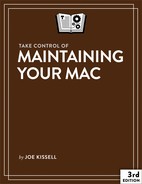Introduction
Back in the early 2000s, I went to the dentist for the first time in many years. After skipping dental visits for far too long, I felt increasingly reluctant to schedule an appointment. I could just hear the dentist chiding me, “Ah, I can see you haven’t had your teeth cleaned properly in five years. For shame!” The more time passed, the worse my embarrassment grew, and finally it took actual pain and a visible hole in a tooth to overcome it. So I was disappointed, but not surprised, to learn that I had several cavities and needed a root canal. The dentist was kind and understanding but nevertheless pointed out repeatedly that this visit might have been much less painful (and less expensive) had I flossed every day and gone for my semiannual checkups as I knew I should have.
I tell you this story not merely to urge proper dental hygiene but because maintaining your Mac—like maintaining your teeth, your car, your health, or your home—is a good habit whose rewards are having fewer problems later on and being able to recover more easily from problems that do arise. You can sometimes get away without doing any maintenance for a few months or perhaps much longer, but you risk losing data, wasting time, and having to spend a great deal of money repairing or replacing your computer.
This book teaches you the most important and useful maintenance tasks you should perform to increase your chances of keeping your Mac in tip-top operating condition throughout its lifetime. I’ve organized the tasks according to their frequency: what you should do daily, weekly, monthly, and yearly, as well as some important initial steps, some things you should do when a macOS upgrade appears, and some tasks you might want to avoid, contrary to conventional wisdom. If you follow these recommendations diligently, you’ll dramatically decrease the likelihood of serious problems. And if problems do occur, you’ll be far more likely to recover from them gracefully.
I want to make a few disclaimers up front:
There’s no such thing as the One True Way to maintain your Mac. Everyone’s situation is unique, so you may need to adapt these instructions to suit your needs—perform certain tasks more often or less often, skip tasks that don’t apply to you, and so on. Take these instructions as guidelines, as a starting point to determine your own maintenance regimen.
No amount of maintenance can guarantee that you’ll never have any problems. Manufacturing defects, malfunctioning software, user errors, and other mishaps can and do occur. Proper maintenance should, however, minimize both the number and the severity of problems you experience.
This book does not cover troubleshooting or repair; the focus is on preventing problems, not fixing them. If your Mac crashes, loses data, fails to start up, or otherwise behaves improperly, I refer you to my book Take Control of Troubleshooting Your Mac.
This version of Maintaining Your Mac is geared toward people using 10.9 Mavericks or later, including 10.14 Mojave. The majority of the information in this book also applies to earlier versions of macOS. Even so, note that one of my first suggestions is to upgrade your Mac to run the latest version of the operating system, which is likely to contain fewer bugs than earlier versions.
To see if there’s anything new that you need to know since this book was released or if there’s a newer version of this book, check for updates using the link at the top of the About This Book chapter.
The tasks in this book are easy, and they get easier the more you do them. So start developing those good maintenance habits right now. And don’t forget to floss every day!
